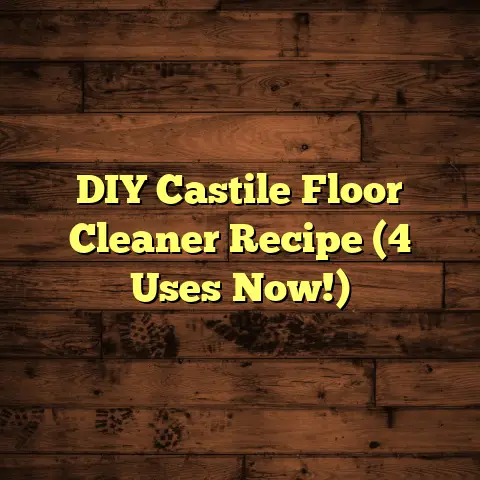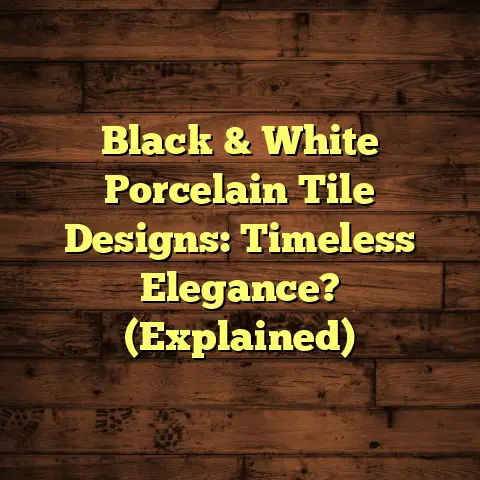LVT in Bathrooms: Good Idea? (4 Things To Know!)
Ever notice how the bathroom is the only room in the house where you can sit, stand, or even dance while contemplating life’s biggest questions—like, ‘Why did I think shag carpeting was a good idea?’
Choosing the right flooring for this sanctuary
is crucial.
It needs to withstand splashes,
humidity, and the occasional dropped hair dryer.
That’s where Luxury Vinyl Tile (LVT) comes in.
But is it really a good idea for your bathroom?
Let’s dive into the nitty-gritty.
What is LVT (Luxury Vinyl Tile)?
Okay, let’s get this straight.
LVT isn’t your
grandma’s vinyl flooring.
We’re talking a serious
upgrade here.
LVT stands for Luxury Vinyl Tile.
It’s designed
to mimic the look of natural materials like wood,
stone, or ceramic tile.
Think of it as the
chameleon of the flooring world.
But unlike those materials, LVT is engineered
for resilience.
It’s typically composed of
several layers:
Wear Layer: This is the top layer, the bodyguard that protects against scratches, stains, and fading.
The thicker the wear layer, the more durable the LVT.
I usually recommend at least a 20 mil wear layer for bathrooms.Print Layer: This is where the magic happens.
High-definition printing technology creates realistic visuals, from wood grain to stone patterns.Core Layer: This provides the structure and stability of the tile.
Options include rigid core (like SPC or WPC) and flexible core.
Rigid core is generally more water- resistant and dimensionally stable, making it a great choice for bathrooms.-
Backing Layer: This adds comfort underfoot and helps with sound absorption.
LVT vs. The Competition
So, how does LVT stack up against other flooring options?
Traditional Vinyl: LVT is thicker, more durable, and offers better visuals than traditional sheet vinyl.
Think of it as vinyl’s sophisticated older sibling.Tile: Tile is undeniably durable and waterproof.
But it can be cold and hard underfoot.
LVT offers a warmer, softer alternative while still providing excellent water resistance.
Plus, installation is often easier and less messy.Laminate: Laminate looks like wood, but it’s not very water-resistant.
A single flood could ruin it.
LVT, on the other hand, can handle moisture like a champ.
A Brief History
Vinyl flooring has been around for decades, but
LVT is a relatively recent innovation.
It gained
popularity in the early 2000s as manufacturers
developed better printing technologies and more
durable wear layers.
Today, LVT is a top choice for homeowners and designers alike, thanks to its combination of style, durability, and affordability.
Water Resistance and Durability
Let’s face it: bathrooms are wet places.
Showers
splash, kids spill, and toilets sometimes overflow.
Your flooring needs to be able to handle it all.
LVT: The Water Warrior
One of the biggest advantages of LVT is its
water resistance.
Most LVT is completely
waterproof, meaning water won’t penetrate the
surface and damage the core.
This is especially important in bathrooms, where moisture can lead to mold, mildew, and structural damage.
Pro Tip: Look for LVT with a rigid core,
such as SPC (Stone Polymer Composite) or WPC
(Wood Polymer Composite).
These cores are
virtually waterproof and won’t warp or buckle
when exposed to moisture.
Durability That Lasts
But water resistance isn’t the only thing that
matters.
Your bathroom floor also needs to be
able to withstand daily wear and tear.
LVT is known for its durability.
The wear layer
protects against scratches, scuffs, and stains.
A thicker wear layer means more protection.
I’ve seen LVT floors hold up beautifully in high- traffic bathrooms for years, even with kids and pets.
LVT vs. The Elements
How does LVT compare to other flooring options in terms of water resistance and durability?
As you can see, LVT offers a great balance of
water resistance and durability.
It’s not quite
as indestructible as tile, but it’s much more
water-resistant than laminate or hardwood.
Innovations in LVT Technology
Manufacturers are constantly innovating to improve the performance of LVT. Some recent advancements include:
-
Enhanced Wear Layers: New coatings offer even greater scratch and stain resistance.
-
Antimicrobial Treatments: These help prevent the growth of mold and bacteria.
-
Improved Core Technology: SPC and WPC cores are becoming more rigid and stable.
These innovations make LVT an even better choice for bathrooms.
Comfort and Aesthetic Appeal
Okay, so LVT is durable and water-resistant. But what about comfort and style?
Comfort Underfoot
Let’s be honest: stepping onto a cold tile floor on a winter morning is not a pleasant experience.
LVT, on the other hand, is much warmer and softer
underfoot.
The multiple layers provide insulation
and cushioning.
This can make a big difference in the overall
comfort of your bathroom.
Especially if you live
in a colder climate.
The Chameleon of Flooring
One of the biggest selling points of LVT is its
aesthetic versatility.
Thanks to high-definition
printing technology, LVT can mimic the look of
just about any natural material.
Want the look of hardwood without the worry of
water damage?
There’s an LVT for that.
Dreaming of a marble bathroom without the hefty
price tag?
LVT can make it happen.
The possibilities are endless.
Real-World Transformations
I’ve seen firsthand how LVT can transform a
bathroom.
I once worked on a project where the
homeowner wanted to create a spa-like retreat.
We installed LVT that looked like natural stone.
The result was stunning.
The bathroom felt warm,
inviting, and luxurious.
The homeowner was thrilled.
Designer Insights
I spoke with interior designer Sarah Miller about her experience with LVT in bathrooms.
“I love using LVT in bathrooms because it gives
me so much design flexibility,” she said.
“I can
achieve the look of high-end materials without
breaking the bank.
And my clients love how
comfortable it is underfoot.”
LVT Styles to Consider
Here are some popular LVT styles for bathrooms:
-
Wood-Look LVT: Perfect for creating a warm, inviting atmosphere.
-
Stone-Look LVT: Adds a touch of elegance and sophistication.
-
Tile-Look LVT: Offers a classic, timeless appeal.
Cost-Effectiveness and Installation
Let’s talk money.
How does LVT compare to other
flooring options in terms of cost?
And what about
installation?
The Price is Right
One of the biggest advantages of LVT is its
cost-effectiveness.
It’s typically less expensive
than natural materials like hardwood, stone, or
ceramic tile.
The exact cost will depend on the quality of the
LVT and the complexity of the installation.
But
in general, you can expect to save money by
choosing LVT.
DIY vs. Professional Installation
LVT is relatively easy to install.
Many types of
LVT feature a click-lock system, which allows
you to simply snap the tiles together.
This makes it a great option for DIYers.
However,
if you’re not comfortable with home improvement
projects, it’s best to hire a professional.
A professional installer will ensure that the LVT
is properly installed and that the seams are
watertight.
This can help prevent problems down
the road.
Pro Tip: Proper subfloor preparation is
crucial for a successful LVT installation.
Make
sure the subfloor is clean, level, and dry before
you start.
Long-Term Savings
The initial cost of LVT is just one factor to
consider.
You also need to think about long-term
savings.
LVT is incredibly durable and easy to maintain.
It doesn’t require sealing or waxing, and it’s
resistant to stains and scratches.
This means you’ll spend less time and money on maintenance over the life of the floor.
Cost Breakdown
Here’s a rough estimate of the cost of LVT installation, compared to other flooring options:
These are just estimates, of course.
The actual
cost will vary depending on your location and
the specific products you choose.
Conclusion: Is LVT the Right Choice
for Your Bathroom?
So, is LVT a good idea for your bathroom?
The answer, as always, depends on your individual needs and preferences.
LVT offers a compelling combination of water
resistance, durability, comfort, and style.
It’s also relatively affordable and easy to
install.
The Benefits of LVT
Here’s a quick recap of the benefits of LVT in bathrooms:
-
Water Resistance: LVT is virtually waterproof, making it ideal for wet environments.
-
Durability: LVT can withstand daily wear and tear, scratches, and stains.
-
Comfort: LVT is warmer and softer underfoot than tile or stone.
-
Style: LVT offers a wide range of colors, patterns, and finishes to suit any style.
-
Cost-Effectiveness: LVT is typically less expensive than natural materials.
Potential Drawbacks
Of course, LVT isn’t perfect. Here are a few potential drawbacks to consider:
-
Not as Durable as Tile: While LVT is durable, it’s not quite as indestructible as tile.
-
Can Be Damaged by Sharp Objects: LVT can be scratched or gouged by sharp objects.
-
Not Always the Most Eco-Friendly Option: Some LVT products contain PVC, which is not the most environmentally friendly material.
Making the Right Choice
Ultimately, the decision of whether or not to use LVT in your bathroom is a personal one.
Consider your budget, your style preferences, and
your lifestyle.
If you’re looking for a
durable, water-resistant, and stylish flooring
option that won’t break the bank, LVT is
definitely worth considering.





